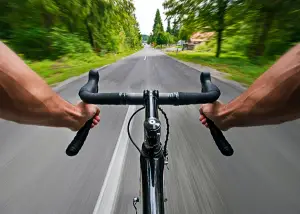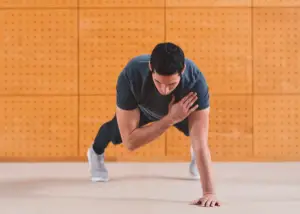You just had rotator cuff surgery, and you’re dying to know when you can get back to riding your bike? You are probably sitting in a sling and uncomfortable, trying to figure out when you can hit the road or mountain again.
The truth is that you will get back on your bike, but the question that lingers is “when?” This will depend on several factors; type of rotator cuff surgery, healing time, and type of riding you do. Let’s tackle these items now.
More About Rotator Cuff Recovery
 Rotator cuff surgery is a common shoulder surgery performed after an injury to one of your rotator cuff muscles. This is a complex surgery that requires appropriate healing time to have a successful outcome. Rotator cuff repair surgery is typically performed arthroscopically, and you go home the same day.
Rotator cuff surgery is a common shoulder surgery performed after an injury to one of your rotator cuff muscles. This is a complex surgery that requires appropriate healing time to have a successful outcome. Rotator cuff repair surgery is typically performed arthroscopically, and you go home the same day.
Having a torn rotator cuff repaired is not an easy undertaking. The recovery is difficult and lengthy. However, when done correctly with a physical therapist, you will have a successful outcome. You can usually expect to return to activity in 6-12 months. Your best ally will be your physical therapist, who will guide you through your post-operative progression and get you on track to get back on your bike.
Getting Back on a Bike After Rotator Cuff Surgery
Now, depending on the type of riding you are aiming to get back to, you will have different timelines on return to the saddle.
Typically, you have the green light to use a stationary recumbent bike two weeks after your surgery. This allows you to start your cardio back up while keeping your shoulder safely in a sling.
Using a spin bike or upright stationary bike can be started around 12 weeks after your surgery. Around this time, your exercises in physical therapy will have progressed and allowed you to begin weight-bearing activities through your shoulder.
You will start to incorporate modified push-ups and planks, which will help strengthen your shoulder stabilizers which you will need to grip and hold your handlebars. Without this strength, you will not hold your body weight through your arms and support yourself on your handlebars.
Riding a Road Bike After Shoulder Surgery
Now you may be wondering why you can’t get out on the road yet, well, the answer is that the road is unpredictable. Your surgeon doesn’t want you out on the road until about 5-6 months because if you fall or get knocked off your bike, you could re-injury your shoulder and possibly requires repeat surgery.

Six months have arrived; let’s talk road biking! At this point, your shoulder is much stronger and nearly fully healed. Now you can safely ride out on the road and get back to your routine. Make sure to start yourself with low mileage and easy elevation.
Start with shorter distances on flat roads and work to progress to increased time and elevation. Ensure that before you increase either distance or elevation, your shoulder is feeling good and isn’t overly sore. At the same time, continue to work on your shoulder strengthening to keep that shoulder healthy and tolerate the pressure through the handlebars
Moutain Biking After Rotator Cuff Surgery
Getting back on the mountain is usually attained between 6-12 months, depending on the severity of your surgery and how you’ve progressed through your physical therapy.
Mountain biking places much greater stress through your shoulder compared to road biking, especially downhill single track. Due to the unpredictability of trail riding, you need to make sure your shoulder is ready for the task.

The other issue is there is a higher risk of crashing or falling when out on the trail, so we need to make sure that your tendon and associated structures in your shoulder have healed.
Progress your trail riding gradually, focus on shorter distances with minimal elevation and slowly progress each of these as your shoulder gets used to the bike.
How to Know You’re Ready to Ride a Bike After Surgery
How do you know if you’re ready to get back on your bike?
Step one would be consulting with your physical therapist, as he or she will help guide you through the process and help you get back to your specific style of riding.
There are a few self-assessments that you can do to test your shoulder.
First, try performing a plank with your arms extended and maintaining your weight. If you can comfortably do this, you can progress to doing this exercise with alternately tapping each shoulder with your opposite hand. This will test out your ability to weight bear through one arm. Can you do it equally in both arms?

You can also perform a modified or full push-up to test your strength. The goal of both assessments is to perform them without pain and failure. These will be significant indicators of whether or not your arm will be able to sustain your weight through the handlebars.
FAQ About Torn Rotator Cuffs and Cycling
Can you bike with a torn rotator cuff?
Absolutely. If you have a fully or partially town rotator cuff that has not been surgically repaired then you can still ride a bike. It comes down to pain tolerance in the shoulder. Exercise and general weight-bearing in the injured shoulder is even beneficial for a torn rotator cuff.
Can cycling cause a torn rotator cuff?
No, not unless you crash or do something abnormal on the bike like reach and grab a pole while you are reading. Cycling is a safe activity for your shoulders. Any torn rotator cuff diagnosis likely occurred from wear and tear or from a previous injury.
Can I bike with a shoulder sling on?
No, it’s not a good idea unless it is the stationary or recumbent bike. It’s difficult to get on and off a stationary bike without turning on shoulder muscles that need time to heal in the sling.
When can I ride the stationary bike after shoulder surgery?
Typically surgeons will say once you can start weight-bearing in the shoulder around 12-weeks. We have start patients as early as 6-8 weeks if they don’t use their surgically repaired shoulder on the handle bars and ride in the upright position. The sustained pressure in the shoulder could be an issue that early in the recovery.
In Review
Getting back in the saddle after rotator cuff surgery is attainable and successful if you follow the appropriate steps and precautions. Your timeline may vary depending on your riding style, but the good news is you will get back on the bike. Follow your post-operative protocol closely, go to physical therapy, and work hard. You’ll be back on your bike in no time!
Author Information:
Written By: Cecile Younes PT, DPT, Cert DN, MST, VRS
Dr. Cecile Younes is a graduate of Franklin Pierce University where she received her Doctorate of Physical Therapy in May 2015. She attended the University of Delaware where she obtained her undergraduate degree in Health Behavior Science along with two minors in Coaching and Strength & Conditioning. Cecile is also certified in Dry Needling through the Dry Needling Institute. Cecile is also pursuing a certification in Spinal Manipulation through the American Academy of Manipulative Therapy, Spinal Manipulation Institute. She played Division I softball and as a result brings to her work a personal understanding of the drive and passion of athletes, and of the difficulties involved in recovering from athletic injury. Her personal experience allows her to motivate and inspire her patients through the process of post injury/surgery rehabilitation. She specializes in a variety of musculoskeletal and orthopedic conditions.
Other Great Rehab Related Articles
GLP Weight Loss and Back Health: Effective Strategies and Insights
How to Stay Active After Cervical Fractures: Expert Tips and Advice
Dealing with Painful Stairs After Ankle Replacement Surgery
Walking After a Total Ankle Replacement: Tips for a Successful Recovery
Exercises While Non-Weight Bearing After Ankle Replacement: Elevation, AROM, Leg Raises, and More
Ankle Pain with Stairs: Causes and Home Treatment Options
Disclaimer: The information provided in this post is for educational purposes only. This is not a substitute for a medical appointment. Please refer to your physician before starting any exercise program.






